Our Programs
Generating Power from Sea Level Rise: Filling-in Natural Depressions by Design
Many things about global climate change are uncertain. But one thing is certain, sea level is rising and rising pretty fast. Is there any way we can use this phenomenon to our advantage rather than have it work against us? Is there some way we could benefit from it, perhaps in a big way?
The answer is a resounding “Yes!” Many areas on land are known to be below sea level. In the United States, of course, Death Valley, California comes to mind. It is one of the most familiar such places to Americans but there are many other places which are below sea level around the world as well. Some of them are really far below sea level, and occupy thousands of square miles, such as the Qattara Depression. They are going to be filled with water eventually anyway, so why not fill them intentionally, first? And generate hydroelectric power while we’re doing so from the engineered flow of vast volumes of sea water into these already-doomed, “depressed” areas? Why not turn a “bad” thing into a “good” thing?
This would clearly be a practical solution to one of the thorniest problems of climate change. By doing so, we can generate billions of megawatt hours of carbon-free electricity, entering into a virtuous cycle of mitigation/reduction with a true “self-reinforcing” solution.
A side benefit of this approach is that cities and other coastal communities threatened with extinction will be given much-needed breathing time to develop ways to combat the catastrophic flooding that they face, and/or, in the best of all possible worlds, might not have to spend as much money on relocation programs and/or building seawalls and other infrastructure that might be needed for proper climate resilience.
We believe this is one of the best possible solutions to one of the biggest problems of climate change that we face. It gets an “A+” rating.
Where can we build these projects which will help to save human civilization from an out-of-control rise of the seas, driven by an inexorable melting of the ice-caps? How much power can we generate? How much will it cost? How much of the projected future sea level rise can we mitigate by doing so? These are all questions which research at Practical Climate Solutions seeks to answer accurately, and on a timely basis.
As far as prospective locations go, Dr. David K. Lynch has compiled a list of 33 countries with significant amounts of land below sea level which appears below:
Thirty-Three Countries with Land Areas Below Sea Level | ||
Country | Below Sea Level Location | Elevation |
Israel | Dead Sea shoreline | 408 meters below sea level |
Jordan | Dead Sea shoreline | 408 meters below sea level |
Syria | unnamed location near Lake Tiberias | 200 meters below sea level |
Djibouti | Lac Assal shoreline | 155 meters below sea level |
China | Turpan Pendi | 154 meters below sea level |
Egypt | Qattara Depression | 133 meters below sea level |
Kazakhstan | Vpadina Kaundy | 132 meters below sea level |
Ethiopia | Denakil Depression | 125 meters below sea level |
Argentina | Laguna del Carbon | 105 meters below sea level |
United States | Death Valley | 86 meters below sea level |
Eritrea | near Kulul within the Denakil Depression | 75 meters below sea level |
Morocco | Sebkha Tah | 55 meters below sea level |
Western Sahara | Sebjet Tah | 55 meters below sea level |
Libya | Sabkhat Ghuzayyil | 47 meters below sea level |
Dominican Republic | Lago Enriquillo | 46 meters below sea level |
Algeria | Chott Melrhir | 40 meters below sea level |
Azerbaijan | Caspian Sea shoreline | 28 meters below sea level |
Iran | Caspian Sea shoreline | 28 meters below sea level |
Russia | Caspian Sea shoreline | 28 meters below sea level |
Tunisia | Shatt al Gharsah | 17 meters below sea level |
Australia | Lake Eyre | 15 meters below sea level |
Uzbekistan | Sariqarnish Kuli | 12 meters below sea level |
Mexico | Laguna Salada | 10 meters below sea level |
Denmark | Lammefjord | 7 meters below sea level |
Netherlands | Zuidplaspolder | 7 meters below sea level |
Mauritania | Sebkhet Te-n-Dghamcha | 5 meters below sea level |
Japan | Hachiro-gata | 4 meters below sea level |
United Kingdom | The Fens | 4 meters below sea level |
Germany | Neuendorf bei Wilster | 3.54 meters below sea level |
Sweden | reclaimed bay of Lake Hammarsjon, near Kristianstad | 2.41 meters below sea level |
France | Rhone River delta | 2 meters below sea level |
Poland | near Raczki Elblaskie | 2 meters below sea level |
Suriname | unnamed location in the coastal plain | 2 meters below sea level |
The Hydrosol Project
The Hydrosol Project is a program to build a series of greenhouse gas emission-free solar desalination plants around the world. Each plant will be a pyramids-scale structure with the capacity to produce over 1.5 million gallons of fresh water a day using only solar, wind, and tidal power. The architecture and engineering for these structures is in advanced stages. Site selection and geophysical field surveys will be conducted next, as well as discussions with local governments and world water authorities for the necessary approvals. Each project will be a self-supporting public works project and will have a "multiplier effect" on the local economy when finished by furnishing large quantities of potable water for drinking, bathing, sanitation and irrigation. As is well known, a large proportion of the Earth's population today lacks adequate access to clean water, which is thought to be a basic human right. Traditional methods of desalination create large quantities of greenhouse gases, completely unnecessarily.
Below is a picture of Hydrosol Haiti, planned for the island of Gonaive. Several different condenser designs are shown.
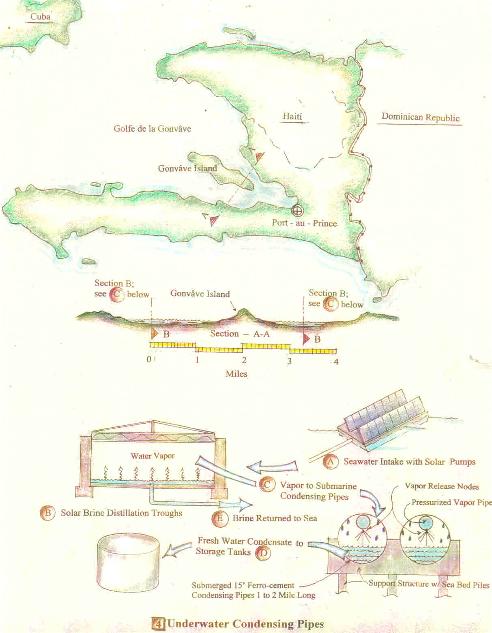
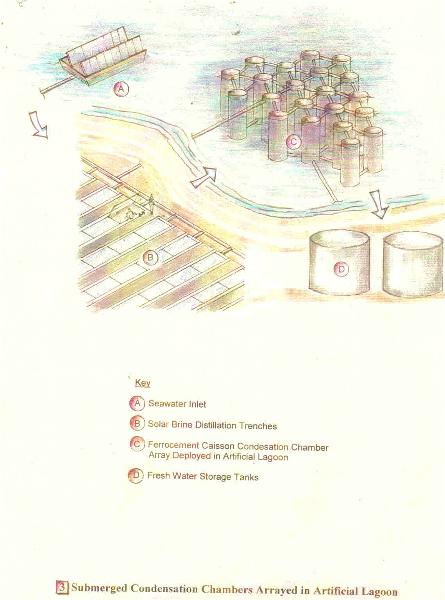
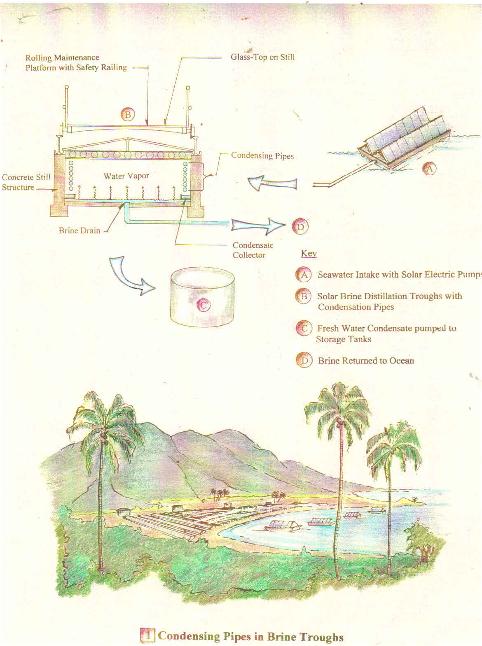
The above sketches were done by Phil Hawes, the architect who designed Biosphere II. The Hydrosol Project has been endorsed by David Rockefeller, the noted philanthropist, and the late Senator Paul Simon (author of "Tapped Out! The Coming Global Water Crisis"), among others.
Typical project cost estimates and operating budgets follow.
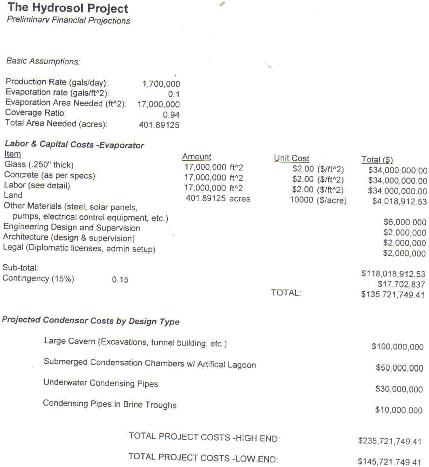
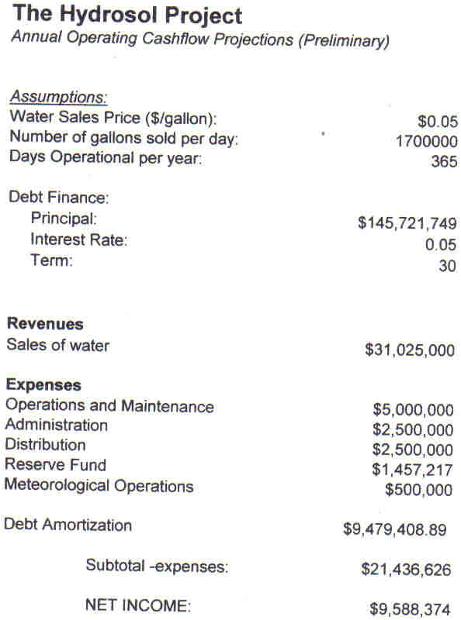
These plants can be built all over the world in coastal communities where local conditions permit. Our research is on-going to solidify the most efficient condensor designs, mechanisms of tidal refill, and methods to prevent the structures themselves from being overcoming by global sea level rise. The objective is to provide the blueprints for plant design so that various governments and NGO's can construct these plants using indigenous labor and autonomous water authorities. As is well known, ample sources of clean potable water have an economic "multiplier" effect, encouraging native industry and agriculture. Each plant will be designed to last for hundreds of years. And, as the above projections show, they are economically self-sustaining.
Green Technology Research
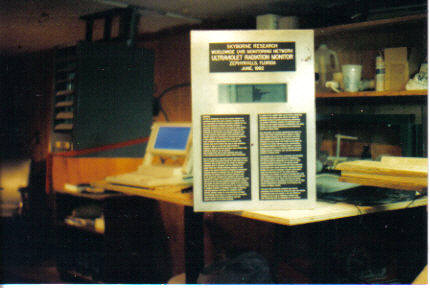
Practical Climate Solutions will investigate new green technologies which will lead to a more prosperous and sustainable future. We will also write reviews of products which purport to be "green" but really aren't. There is a considerable amount of "greenwashing" going on now to make certain products and technologies appear to be green, when the facts dictate against them. The Second Law of Thermodynamics is the ultimate arbiter in all such discussions and a methodical scientific review of all such claims is urgently needed. Certainly the idea to inject sulphate and other particles into the stratosphere to provide shade to mitigate anthropogenic global warming is a crazy, bad idea, and money spent on pursuing this concept is being wasted.